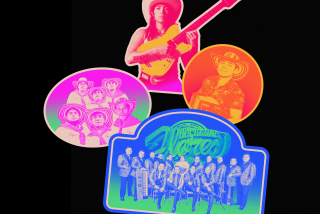Outside of Africa
How’s this for a switch? On Wednesday, St. Patrick’s Day, the featured artists at the Cerritos Center for the Performing Arts will be Ladysmith Black Mambazo.
Not exactly what one would ordinarily expect to hear on the day of the wearin’ of the green? But there is, nonetheless, an unexpected linkage between the African a cappella vocal group and the ancient Celtic holiday.
Ladysmith Black Mambazo was one of the first African music groups to break through to the wider American audience--largely via “Graceland,” the 1986 Paul Simon album that prominently featured Ladysmith. But in recent years, the influence of African music has waned, and the group’s performance on St. Patrick’s Day has an undercurrent of irony, since Celtic music has been rising in popularity as the impact of African music has receded.
Today’s shifting trends in world music reach well beyond the Emerald Isle, however, and if any trend seems dominant it is that more integration, more musical interfacing will occur. Performers from around the world are listening to other musics more closely than ever, and their fascination with one another is having an impact on pop music as well.
“Years ago,” says Alicia J. Cohen, whose Rhythm magazine has become a major information point for world music, “people’s first familiarity with world music was through Paul Simon and Peter Gabriel. What’s interesting is the way it’s coming out now, with Madonna and her Shanti songs on her new CD and with her Chinese outfit at the Grammys. Alanis Morissette is [on] a new CD on Sony Classical with Salif Keita and Nusrat Fateh Ali Khan, and Bonnie Raitt is supposed to be putting something together with Oliver Mutukudzi. As more pop stars become involved with world music, that’s going to open things up a lot.”
How will this increased interaction between musicians affect the music taking place around the world? Here’s a brief look at some of the major areas.
Africa
It’s already a mistake to attempt to categorize an entire continent--and especially a continent with such an enormous diversity of music--under a single name. But some generalities make sense.
The most important is that the African music that originally broke through to Western popularity has been transformed in the past few years, replaced by a more acoustic music impacted to some extent by American singer-songwriters.
“The kind of African music that’s finding an audience has changed,” says Randall Grass, general manager, overseas, of Shanachie Records. “In the beginning it tended to be dance-oriented. Now there’s a definite trend to a more intimate kind of African music. I think that was manifested with Cesaria Evora from Cape Verde, Henri Dikongue from Cameroon, acts like that. I just heard a woman from Mali, Rokia Troare, who I could best describe as a kind of Mali Tracy Chapman.”
Tom Schnabel, the Hollywood Bowl’s newly appointed program director of world music who is bringing Mali singer Oumou Sangare to his “Out of Africa” program on July 25, agrees, underscoring some of the reasons why the changes have taken place.
“The first wave of African music was launched by King Sunny Ade [in the early ‘80s],” says Schnabel. “Everyone was looking for something to come in and be the next thing after Bob Marley passed away. But juju music stayed pretty much the same. Then came the fun of the soukous, but I think African music was compromised by Paris, by Parisian production values, and as soukous went into sort of a disco-type sound, people got tired of it.”
Schnabel says he likes the new acoustic African music, with its “intimate sound.”
“But it’s a bit early,” he adds, “to tell what’s going to happen with the second or third albums from some of these performers, like Lokua Kanza or Henri Dikongue, or even a new guy from Guinea, Alpha YaYa Dialo, who I think has a wonderful sound.”
Central and South America
Cuban and Latin (or Spanish-language) music is the big seller in world music these days. Pop acts such as Ricky Martin and Enrique Iglesias, as well as any number of salsa performers, have huge followings in America’s Spanish-speaking population, and jazz artists have had a strong connection with Cuban music since the ‘40s.
From a broader perspective, the breakthrough came with Ry Cooder’s 1997 recording of Cuba’s Buena Vista Social Club, a Grammy-winning album that has already passed the million mark in international sales.
The lessening of visa restrictions has also permitted a flood of Cuban artists, young and old--Los Van Van, Cubanismo, NG La Banda, Sierra Maestra, Jesus “Chucho” Valdes, Ruben Gonzalez, to name only a few--to make regular U.S. appearances. And the Buena Vista success has sparked a flurry of Cuban recording projects. But the plethora of new product ranges widely in quality, making it difficult for buyers to know what to purchase.
Brazil’s music, the giant presence in the Southern hemisphere, has hit the U.S. market in successive waves, first with the arrival in the ‘40s of Carmen Miranda and the samba; later, in the ‘60s, by the enormously popular (even today) bossa nova music of Joao Gilberto and Antonio Carlos Jobim. The tropicalismo period that followed failed to have much impact on U.S. listeners, largely because they were preoccupied with the pervasive rhythms of American and British rock.
But Brazil, according to David Bither, senior vice president of Nonesuch Records, is showing signs of making yet another of its periodic forays into American musical consciousness.
“I think you could argue that Brazilian music has never really gone away creatively,” he says. “But there does seem to be some interest among younger U.S. and English artists--both on a historic and a current basis. Luaka Bop has the Tom Ze record, and they’ve just put out a bunch of remixes with everyone from Sean Lennon to Tortoise doing stuff with him.”
Schnabel points out that Beck’s latest album includes a track titled “Tropicalia,” noting that few of the people who buy the CD will know that it refers to an important era in Brazilian music.
“But I’ll bet,” Schnabel adds, “that if Tom Ze or a group like that opened for Beck, that all of a sudden people would be talking a lot about Brazilian acts.”
Schnabel makes his own bet on the attractiveness of Brazilian music when he opens the World Festival ’99 series at the Hollywood Bowl on June 26 and 27 with two programs featuring Brazilian superstar Carlinhos Brown and emerging singer Sergio Santos.
Celtic Music
It’s everywhere. From veteran acts such as the Chieftains (a classic example of an ensemble reaching out to interact with performers from various parts of the world) and Clannad to young, new bands such as Solas (which performs at Irvine Barclay Theatre on Wednesday and at the Warner Grand in San Pedro on Thursday).
“Celtic music has always been in the forefront of world music,” Grass says. “It’s one of the small handful of musical traditions that seem to resonate all around the world--a bit like reggae and the blues, which also penetrate every corner.”
The American Irish compatibility has reached well beyond roots and traditional music, into the success of such acts as U2 and Enya.
And, Bither adds, “it just keeps selling.”
*
Trends aside, world music in the U.S. is still not a major presence in the marketplace. But its relatively small overall percentage of sales (impossible to determine, but probably 3% to 5% of the record market) can be deceptive.
“The key with world music,” says Shanachie’s Grass, “is not what percentage of the whole it is, or that most releases won’t sell very much. It’s that a small, select number--such as the Gipsy Kings--will sell very well. And that more reliably shows the depth of interest in world music.
While that “small, select number” don’t exactly compete with major pop music numbers, they can do very well. The Gipsy Kings’ first album and their Greatest Hits album have both sold more than a million copies, and they typically sell around a quarter of a million. Cesaria Evora sells nearly 200,000 per album, and Solas and Ladysmith Black Mambazo check in between 50,000 and 100,000 sales.
Still, the overall marketing of world music in the U.S. is not an easy task. With very little world music available on the radio, companies must resort to in-store promotion to find potential buyers.
Even so, world music seems to be on a solid track into the next century. At a time when the great creative surge flowing through American and British music from the ‘60s and ‘70s appears to be running dry, an opening to the world may well be what will energize the next few decades.
“We’re at a time,” says Schnabel, “when a lot of people who were born in the ‘60s are coming of age, and they’re finding that something’s missing, something that can take them to the next level, whether it’s a rave or a Rahat Fateh Ali Khan concert.
“It’s what I first experienced with [John] Coltrane’s music,” he says. “I couldn’t articulate it or say what was happening, but it took me someplace, because Coltrane was a seeker. If you listen to his music, even now, you’re listening to Indian music, and to African music. And that blending, that searching for the next level is exactly what world music, in all its many forms, has to offer.”*
More to Read
The biggest entertainment stories
Get our big stories about Hollywood, film, television, music, arts, culture and more right in your inbox as soon as they publish.
You may occasionally receive promotional content from the Los Angeles Times.










